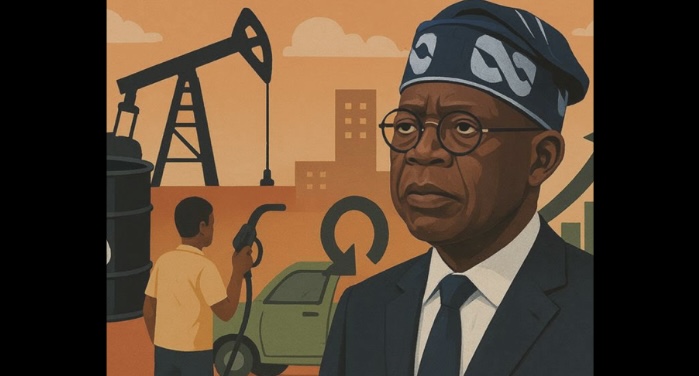For half a century, Nigeria’s most enduring social contract was not enshrined in a constitution but at the petrol pump. Since 1973, successive governments had subsidised the price of petrol, transforming the country’s crude oil endowment into what officials described as a “social product”.
A recent policy paper by the Independent Media and Policy Initiative (IMPI), released in September 2025, captures this trajectory with unusual candour. It traces how subsidies, initially designed to industrialise and stabilise, instead entrenched dependency, drained revenues, and deepened Nigeria’s “resource curse”.
In IMPI’s view, only a decisive rupture could realign the economy, and it is against this backdrop that President Bola Ahmed Tinubu made his most controversial call: ending the subsidy on his first day in office.
The myth of cheap petrol
IMPI’s historical analysis shows that the subsidy began in 1973, when crude oil was fixed at $1.93 per barrel for local refineries, below the international price of $3.00. The gap was defended as industrial policy, but by the 1980s, it had become a fiscal trap.
When oil hit $40 a barrel in 1980, Nigeria kept refinery crude at $13.80, ballooning the subsidy element to over 65 percent. By 1988, as prices crashed to $15, refinery allocations were dropped to $2 a barrel, pushing subsidies as high as 87 per cent.
Over time, this created not only a distortion but also a political myth that cheap petrol was Nigeria’s birthright. A 2023 BBC commentary, cited in the IMPI report, described Nigeria’s economic model as “inappropriate, reliant on oil, with wealth concentrated in the hands of a few and not benefiting the general population.”
Subsidy was less a tool of development than a symbol of inertia.
Why Tinubu jumped first
Every president since Olusegun Obasanjo has toyed with subsidy reform. All retreated under pressure. In 2012, Goodluck Jonathan’s attempt triggered nationwide strikes under the “Occupy Nigeria” movement, forcing a partial climbdown.
Tinubu, however, moved immediately. IMPI notes that announcing on inauguration day left little room for reversal, signalling that the old order was over. Economically, Nigeria had little choice: debt service had consumed over 90 percent of revenues in 2022.
Politically, Tinubu calculated that early pain could be absorbed if dividends became visible before the 2027 elections.
The fiscal space was immediate. In July 2025, the Federation Account Allocation Committee (FAAC) shared N2.001 trillion among federal, state, and local governments, the highest in Nigeria’s history.
For the first time in years, several states paid salaries without resorting to bank borrowing. Imo State raised its minimum wage to N104,000, while other states, such as Lagos and Rivers, set wages at N85,000, and Enugu, Akwa Ibom, and Niger at around N80,000.
Read also: Dangote Refinery Vs DAPPMAN: CORAN calls for calm, restraint, collaboration among oil industry stakeholders
The shock therapy
The short-term pain was brutal. Inflation surged to 34.2 percent in June 2024, the highest since 1999. Household consumption collapsed: IMPI documents a 42 percent contraction in Q1 2024 and a near 100 percent collapse in Q2 year-on-year. Multinationals closed operations, while listed companies declared record losses.
For ordinary Nigerians, the reform felt punitive. “We were told subsidy removal would bring jobs and growth,” says Chinedu Okonkwo, a taxi driver in Abuja. “Instead, fuel is unaffordable, food is expensive, and our lives are harder.”
IMPI acknowledges this dislocation but argues that “rapid price changes established the artificiality that underlined the national economy,” distortions that had constrained development for decades.
Markets applaud, citizens endure.
International markets welcomed the reform. The IMF called it “a critical step towards restoring fiscal sustainability.” Bond investors priced Nigeria more favourably, and portfolio inflows trickled back.
Domestically, however, the backlash was fierce.
Labour unions staged strikes, and opposition leaders framed the reform as “anti-poor”. Yet Tinubu remained unmoved. His administration argued that subsidy removal freed resources for infrastructure and social programmes, citing record FAAC allocations, expanding reserves, and stabilising exchange rates.
The courage of reform
“Tinubu treated subsidy as a political cancer, painful to cut, but fatal if left alone,” says Omoniyi Akinsiju, chair of IMPI, whose policy statement underpins much of this analysis. By documenting the historical arc from 1973 to 2023, the IMPI report states subsidy removal as both a fiscal necessity and a political gamble.
According to IMPI, the administration’s “intransigence” in resisting calls to reverse the policy was critical: without consistency, the reform would have unravelled as quickly as it began.
Dividends at the state level
The clearest early gains have been at sub-national levels. States, long reliant on overdrafts, suddenly had resources. Some raised wages; others launched new infrastructure projects.
IMPI highlights the symbolism: for the first time in years, states were able to meet obligations without emergency borrowing, easing pressure on commercial banks and on households.
Yet critics warn the windfall could be wasted. “The question is not whether states have money now,” argues a former finance minister. “It is whether they will spend it productively.”

